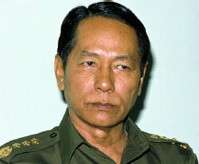
Saw Maung
Senior General Saw Maung (Burmese: စောမောင်, pronounced: [sɔ́ màʊɴ]; 12 May 1928 – 24 July 1997) was the founder of the State Law and Order Restoration Council, later renamed State Peace and Development Council in Myanmar. He served as chairman from 1988 to 1992.
Early life and career
He was born on 12 May 1928 in Mandalay, Upper Burma.
Saw Maung joined the army in 1946, two years before Burma gained independence from Britain, and received a commission in 1952. From 1975 to 1976, he fought against communist insurgents and ethnic rebels along the border with Thailand. In 1976, he became a brigadier general, and in 1981 an adjutant-general. He became armed forces commander in 1983.
Saw Maung was army chief of staff and defence minister in the brief government of Sein Lwin and became chairman of the junta when the army staged its coup in 1988 after the 8888 Uprising. He was effective ruler of the country as head of the State Law and Order Restoration Council (SLORC). He also held the posts of prime minister and foreign minister. As a high-ranking member of the Burma Socialist Programme Party (BSPP), he provided continuity of leadership during a succession of short-lived predecessors that followed the toppling of Ne Win earlier in 1988.
Saw Maung (painter)
Saw Maung (Burmese: စောမောင် [sɔ́ màʊɴ]; 1900–1969) was a Burmese artist. He was the son of the artist Saya Aye (painter) (1872–1930), who in turn was an apprentice of Saya Chone (1866–1917), a young Royal Artist under King Thibaw. Thus, Saw Maung could directly trace his history of training back to the pre-colonial times of Upper Burma when the country was still a monarchy and when Traditional paintings of Buddhist religious scenes was the dominant genre of production.
Life and Work
Saw Maung was widely known for his paintings about the life stories of the Buddha and also for a smaller oeuvre of Western-style portraits and landscapes. He was born in Mandalay in 1900, and began his career as an artist at the age of 14, under his father, Saya Aye, whose business he inherited. In the early colonial period, he achieved recognition through his paintings illustrating magazines such as the Myanmar Alin, Dagon and Kawi Myethman. After the Second World War, he visited London, where he studied European styles of painting and also took trips to the USA, China, and Hong Kong. His paintings exhibited fine workmanship. His illustrations of the sixteen point dreams of King Pasenadi of Kosala still hang on the side walls of Kyauktawgyi Buddha Temple.
Podcasts:

-
by Anne Clark
-
by Kru
-
by Little Dragon
-
by Pain Teens
-
by Martha & The Muffins
Swimming
by: Anne Clark----------
Your body is the shoreline
sometimes I am the sea
clinging desperately
feeling all the contours
Ebbing away
pulled by the tides
- the moon
and digital clocks
sensitive to nothing
Parting hours -
time falls through our fingers
